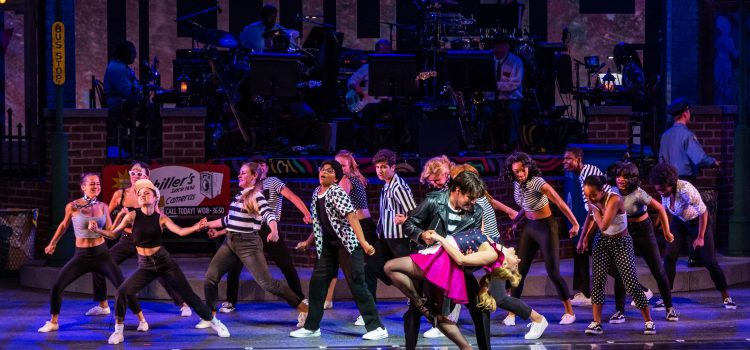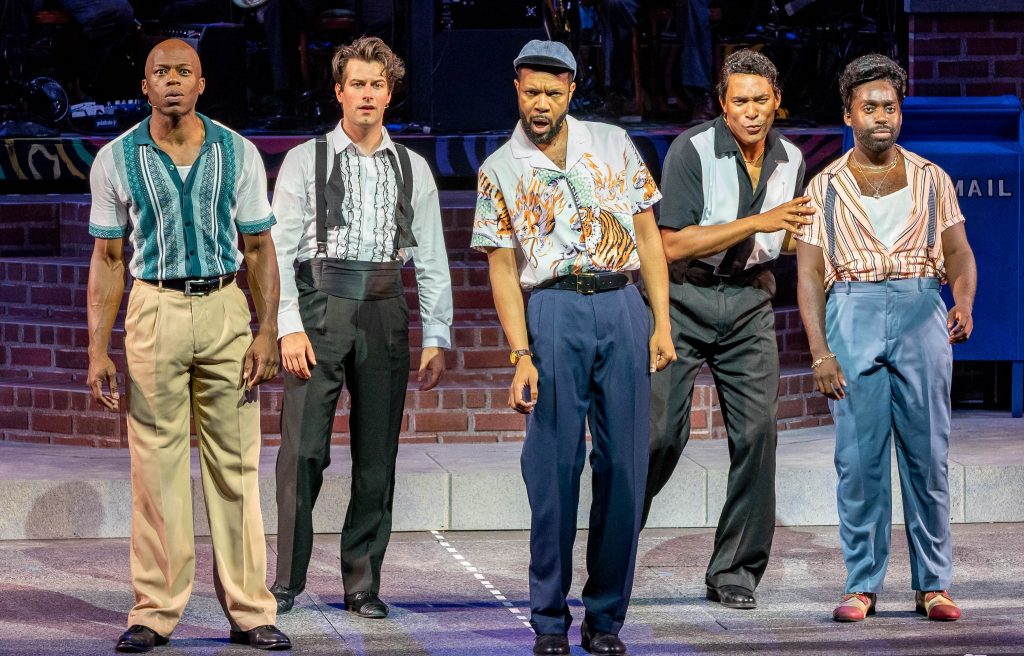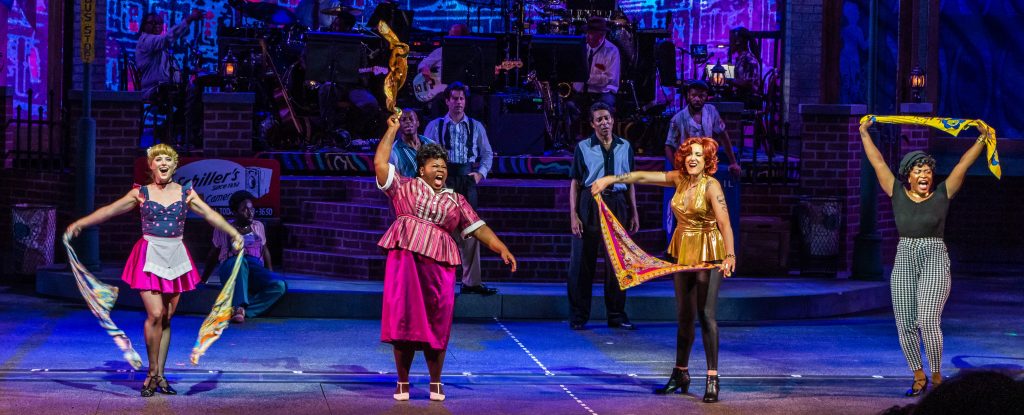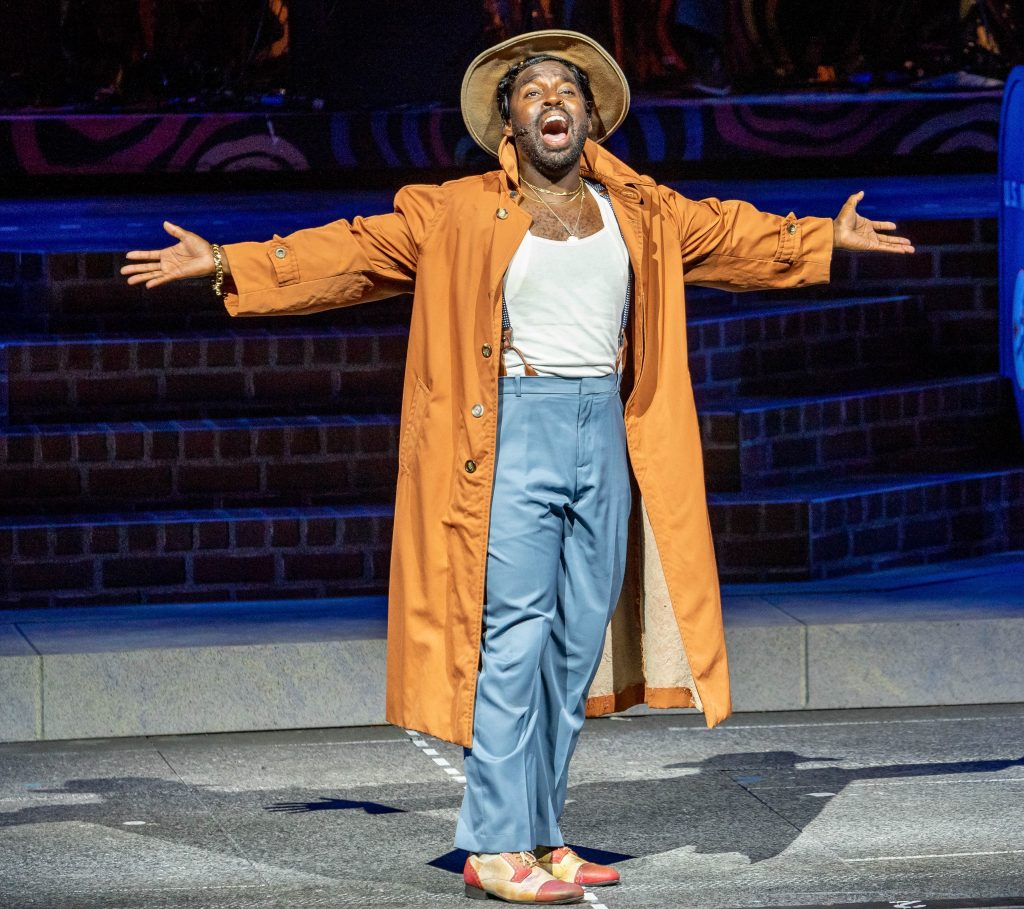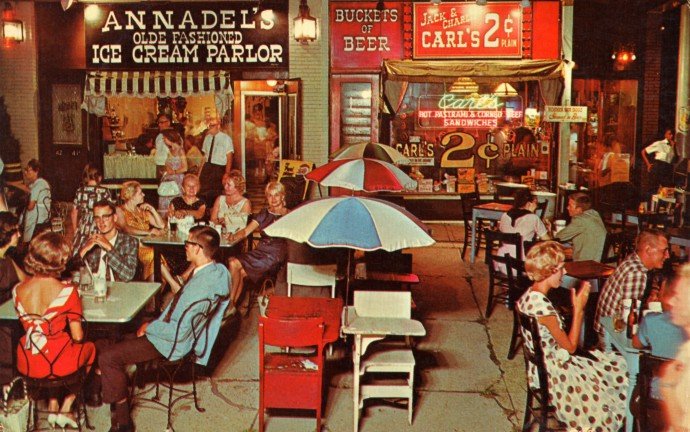By Lynn Venhaus
A jubilant celebration of a Hall of Fame career, “Beautiful: The Carole King Musical” tells the story of how a remarkable singer-songwriter found her voice and influenced a generation.
But it is as much about others who are woven into the history of early rock ‘n roll, and those catchy tunes that have a good beat and you can dance to them, as it is an everlasting tribute to the most successful songwriter of the last half of the 20th century.
King wrote such memorable hits as “I Feel the Earth Move,” “One Fine Day,” “Will You Still Love Me Tomorrow,” “(You Make Me Feel Like) A Natural Woman,” “You’ve Got A Friend,” “So Far Away,” and the title song.
For Boomers, this is the soundtrack of our lives. For other generations, it’s a blast from the past and an introduction to the stories behind the music, and for all, it’s an example of the transformative power of music.
As one of four premieres for The Muny’s 105th season, it was a crowd-pleasing way to open, especially during a stretch of gorgeous weather. I thought it brought fresh air into the venerable institution, for presenting a show from the last decade that has all the makings of a new classic.
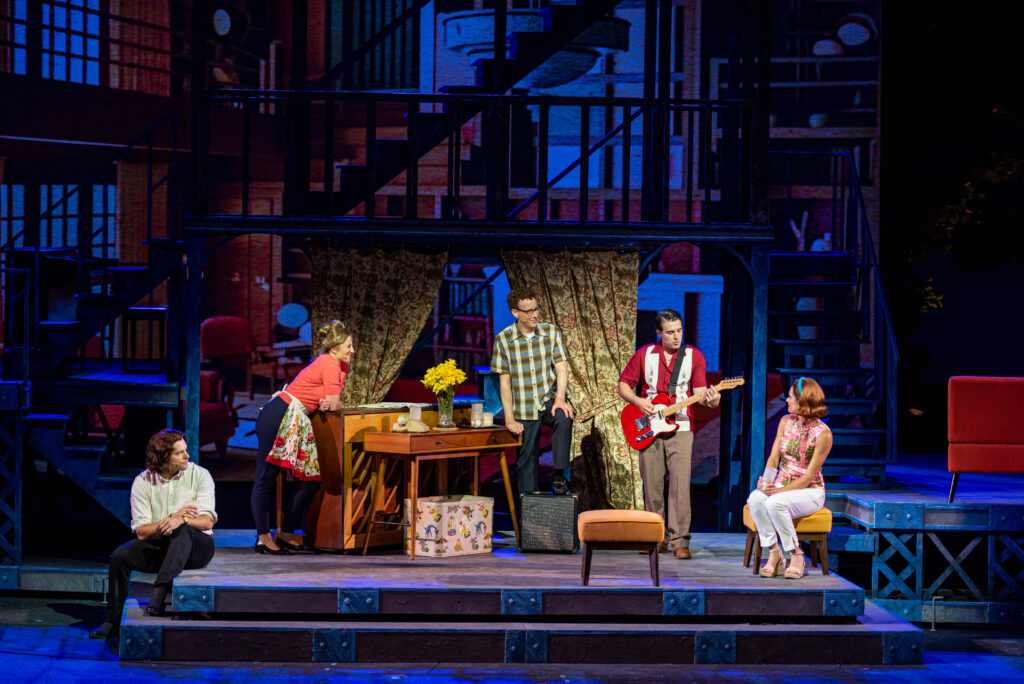
King’s rise to stardom is ideally suited for the Muny, and their interpretation of this jukebox musical is dynamic, slickly staged by director Marcia Milgrim Dodge.
Featuring 26 bouncy pop hits and unforgettable ballads, the music score moves the story along, and music director Charlie Alterman honors that timeless sound with tremendous skill and verve.
Interestingly, there is a Muny connection — Paul Blake produced the Broadway show and he was the Muny’s executive producer for 22 years, until his departure in 2011.
Popular on Broadway, “Beautiful” played for 2,418 performances from Jan 12, 2014, to Oct 27, 2019, nominated for seven Tony Awards and won two – Jessie Mueller as Carole and sound design. Two national tours have played at the Fabulous Fox in St. Louis, in 2016 and 2019.
And the Muny’s creative teams and cast didn’t miss a beat.
With every number performed with gusto, you could feel the audience’s joy in the waves of recognition as patrons named that tune. “”Oh!” followed by cheers and applause.
The most frequent comment I overheard was “I didn’t know she wrote all those songs!”
That, indeed, is an engaging calling card for this well-constructed musical, which features a witty book by Douglas McGrath to accompany the American song catalogue.
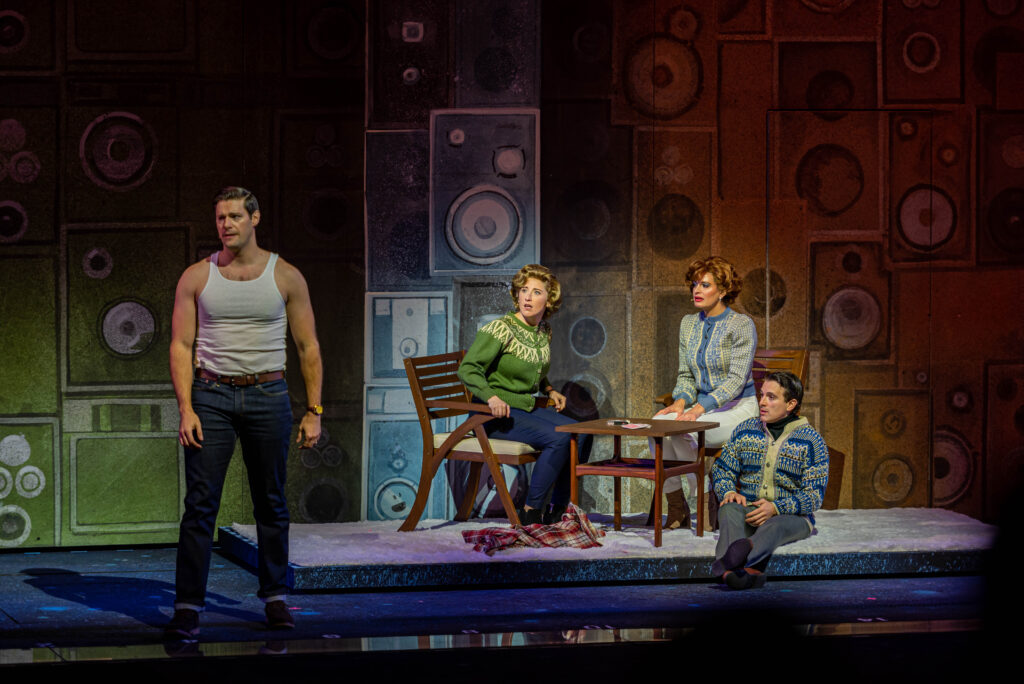
Born Carol Klein, the chart-topping music legend grew up in Brooklyn and then fought her way into the record business as a teenager. She met Gerry Goffin, her match in life and love, at Queens College, and they were married for 10 years, from 1959 to 1969. By the time she was in her 20s, she was flourishing as a songwriter in the fabled Brill Building, churning out hits for the biggest rock ‘n roll acts — Gerry’s words and her music.
It wasn’t until her personal life unraveled that she finally managed to find her true voice, culminating in her landmark solo “Tapestry” album in 1971, which won four Grammys – including Record, Song and Album of the Year — and went on to be one of the greatest selling albums of all-time.
The addition of Cynthia Weil and Barry Mann to the story of Goffin and King makes this musical more than one-note, and with performances by the acts who recorded the songs — The Drifters, The Chiffons and The Shirelles, it’s a sentimental walk down memory lane. Muny hometown favorite Kennedy Holmes shines belting out “The Loco-Motion” as their baby sitter, Little Eva.
Using a moving labyrinth skyscraper grid, scenic designer Ryan Douglass shows the inner workings of the fabled Brill Building, at Broadway and 49th St. in New York City.
That’s an important part of music history, and in this musical. A hit-making music factory, the Brill Building was not only home to Goffin-King and Mann-Weil, but also Burt Bacharach-Hal David, Mike Lieber-Jerry Stoller, and Jeff Barry-Ellie Greenwich.
Between them, they penned scores of hits for the girl groups and teen idols who dominated radio airwaves after Elvis joined the Army in 1958 and before The Beatles ushered in the British Invasion in 1964. But also, still formidable duos beyond with the ‘now sound.’
Using the LED screens, video designer Kylee Loera replicated old-timey television where we watched the popular acts in black-and-white.
Sara Sheperd is a warm and winsome Carole, charting her growth from shy but talented teen to a strong, independent solo artist whose “Tapestry” album released in February 1971 was a landmark achievement – more than 25 million copies sold and longest run on Billboard chart by a female artist.
When the character discovers her worth after heartache and pain, it’s a thrilling moment.
Steven Good emphasizes how gifted and how troubled Gerry Goffin was. (Goffin died in 2014 at age 75, and did see “Beautiful” on Broadway before he passed. He and Carole married three more times in their lives.)
Jackie Burns and Jarrod Spector are sensational as Cynthia Weil and Barry Mann, the songwriting team in the next cubicle, and the competitiveness resulted in many standards that defined the rock era.
Spector, who originated the role on Broadway, nails Mann’s character quirks with aplomb, stealing the show.
John Battagliese and Mike Schwitter as The Righteous Brothers brought the house down with a soulful “You’ve Lost That Lovin’ Feeling.”
There’s also strong support from Noah Weisberg as mentor and boss Don Kirschner, and Sharon Hunter as Carole’s nagging mom Genie
The emotional journey isn’t an easy one, and the book ends in 1971, glossing over some events and not following up what happened as a coda. This tale is focused on the King-Goffin relationship and the work, highlighting the changing times for frames of reference.
The fashions by Tracy Christensen smartly captured the era whereas J. Jared Janas has selected the right hairstyles for the appropriate times and situations.
Savor this satisfying, fun, vibrant musical in its Muny premiere, where it will make you feel ‘Home Again’ for another summer.
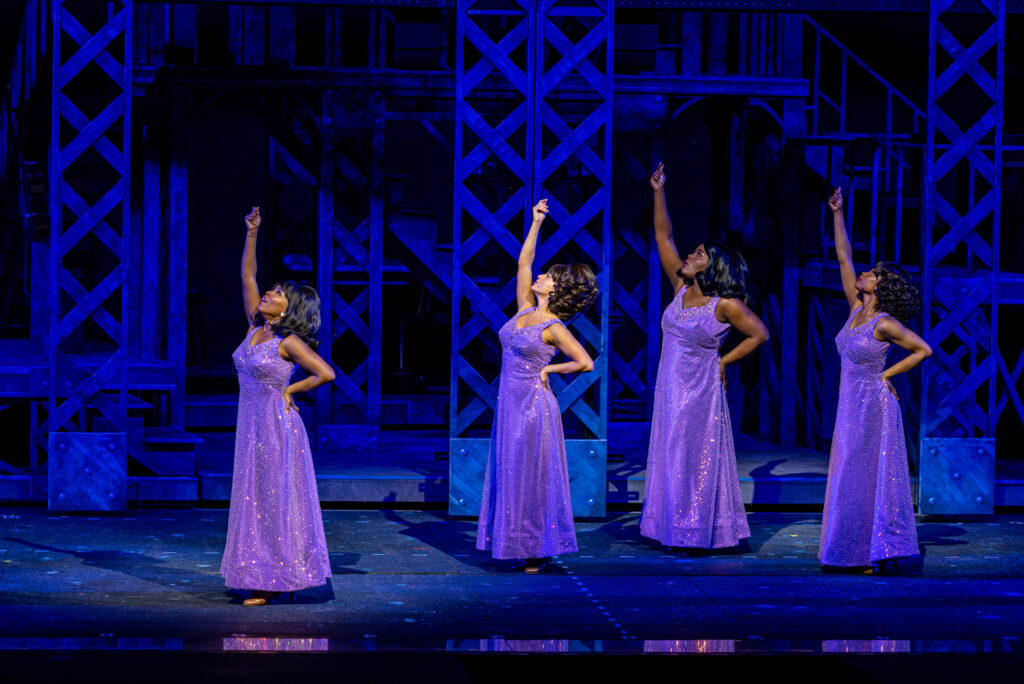
“Beautiful: The Carole King Musical” opens the 105th Muny season, with performances at 8:15 p.m. nightly June 12-18. For more information, visit www.muny.org.
Photos by Phillip Hamer
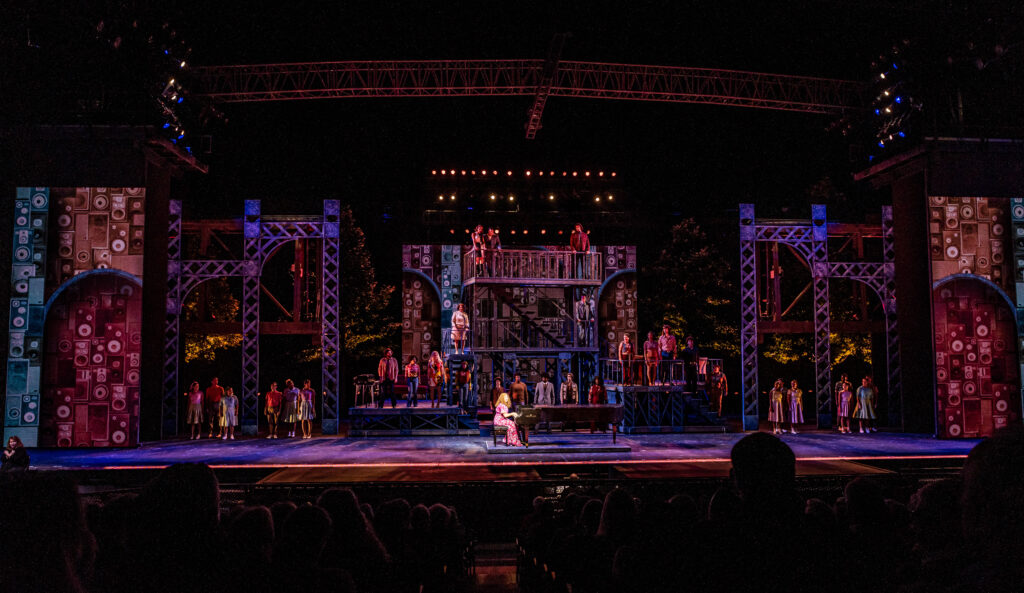

Lynn (Zipfel) Venhaus has had a continuous byline in St. Louis metro region publications since 1978. She writes features and news for Belleville News-Democrat and contributes to St. Louis magazine and other publications.
She is a Rotten Tomatoes-approved film critic, currently reviews films for Webster-Kirkwood Times and KTRS Radio, covers entertainment for PopLifeSTL.com and co-hosts podcast PopLifeSTL.com…Presents.
She is a member of Critics Choice Association, where she serves on the women’s and marketing committees; Alliance of Women Film Journalists; and on the board of the St. Louis Film Critics Association. She is a founding and board member of the St. Louis Theater Circle.
She is retired from teaching journalism/media as an adjunct college instructor.


